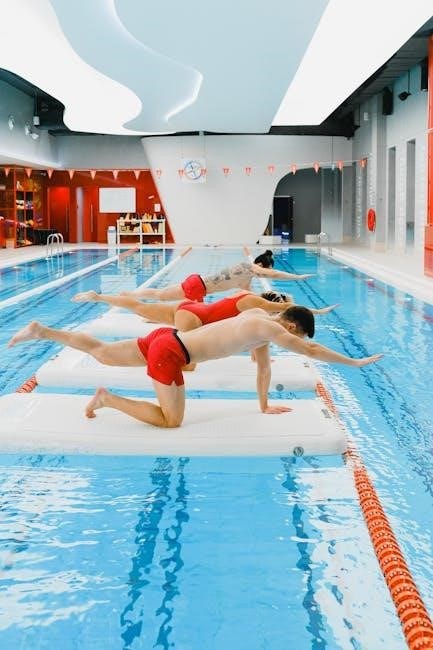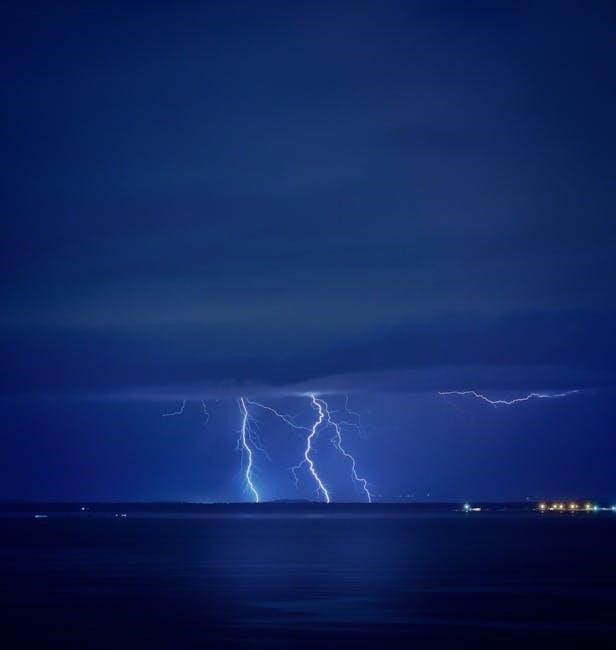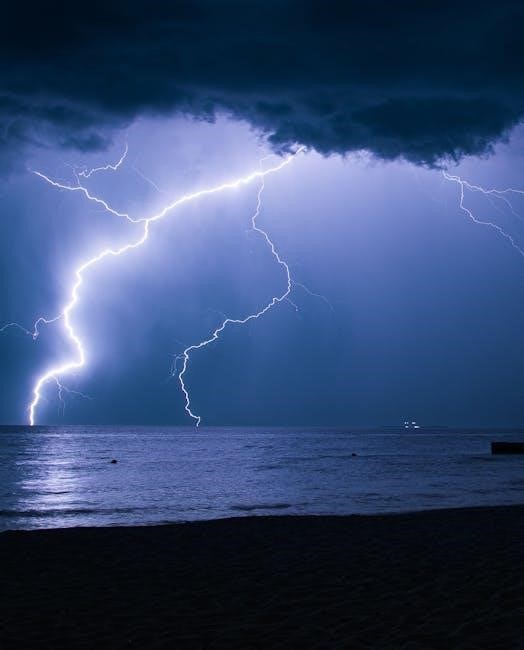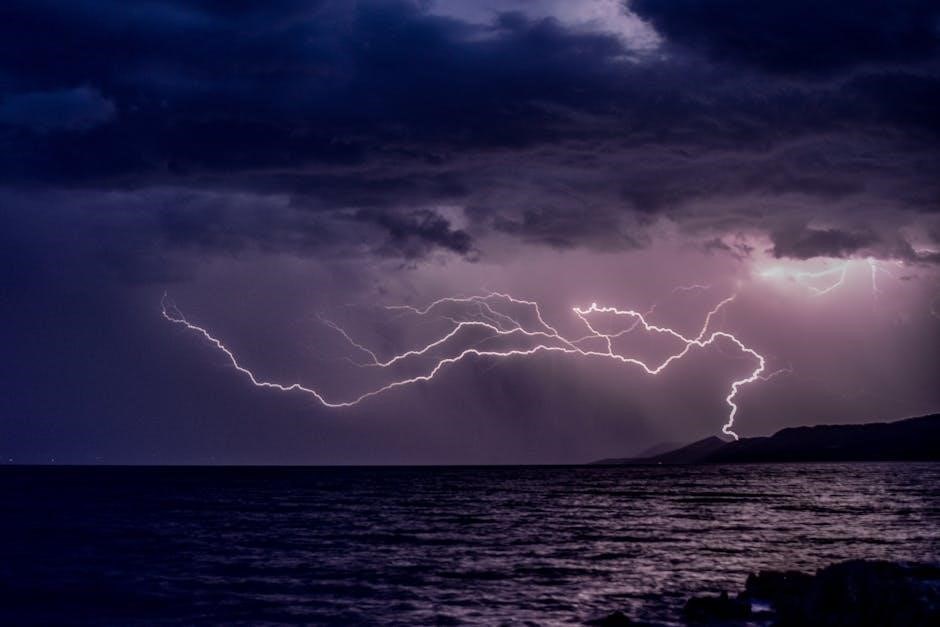Electric water heaters are common household appliances that use electricity to heat water for domestic use. They are essential for providing hot water in homes and businesses, offering a reliable and efficient solution. These systems typically consist of an insulated tank with heating elements that warm the water to a set temperature. Proper installation and maintenance are crucial for optimal performance. This guide explores key aspects of electric water heaters, including energy efficiency, operation, and environmental impact.
What Is an Electric Water Heater?
An electric water heater is a household appliance designed to heat and store water for domestic use. It typically consists of an insulated tank with one or more heating elements, such as resistive coils, that convert electrical energy into heat. These elements warm the water to a preset temperature, which is maintained by a thermostat. Electric water heaters are widely used due to their simplicity, reliability, and compatibility with standard household electrical systems. They are available in various sizes to suit different hot water demands, from small under-sink units to large whole-house systems. Unlike gas models, electric water heaters do not require venting, making them easier to install in many locations.
How Do Electric Water Heaters Work?
Electric water heaters heat water using one or more heating elements inside an insulated tank. Cold water enters the tank, and the elements warm it to a preset temperature. The process begins when the thermostat detects a drop in water temperature, activating the heating elements. Once the desired temperature is reached, the thermostat switches off the elements. Hot water rises to the top of the tank and is distributed through the household plumbing system when needed. Some models use dual heating elements for faster recovery, while others employ advanced technologies like heat pumps for higher efficiency. Proper insulation ensures minimal heat loss, maintaining the water temperature and reducing energy consumption. Regular maintenance, such as checking thermostat settings and inspecting elements, helps ensure optimal performance.

Energy Efficiency Considerations
Energy efficiency in electric water heaters is influenced by factors like insulation, temperature settings, and heating element efficiency. Proper insulation reduces heat loss, while lower temperature settings decrease energy use.
Understanding Energy Star Ratings
Energy Star ratings are a key indicator of an electric water heater’s energy efficiency. These ratings are awarded by the U.S. Environmental Protection Agency to products that meet strict energy efficiency guidelines. A product with the Energy Star label consumes less energy while maintaining performance. For water heaters, the rating is based on annual energy usage and operating costs. The yellow EnergyGuide label provides detailed information, including energy efficiency metrics. Higher-rated models may qualify for rebates or incentives, reducing upfront costs. Choosing an Energy Star-certified heater helps reduce energy bills and environmental impact. Always look for the Energy Star logo when selecting a new electric water heater to ensure it meets efficiency standards.
How to Choose an Energy-Efficient Model
Choosing an energy-efficient electric water heater involves considering several factors to minimize energy consumption while meeting your hot water needs. Start by checking the Energy Star rating, as certified models are designed to use less energy. Look for the EnergyGuide label to compare annual energy usage across different models. Consider the size of the heater—undersized units may work harder, while oversized ones waste energy. Opt for models with advanced insulation to reduce heat loss. Additionally, explore features like thermal heat pumps or smart controls that optimize efficiency. Finally, evaluate the cost and long-term savings to ensure the model aligns with your budget and environmental goals. Proper selection can significantly reduce energy bills and environmental impact.

Factors Affecting Energy Consumption
Temperature settings, insulation quality, and household usage patterns significantly influence energy consumption. Higher temperatures and poor insulation increase energy use, while efficient habits reduce it.
Temperature Settings and Their Impact
Temperature settings play a significant role in the energy efficiency and performance of electric water heaters. Lowering the thermostat can reduce energy consumption, as higher temperatures require more energy to maintain. For instance, heating water from 55°F to 120°F uses 7.6 kWh, while increasing it to 160°F requires 12.3 kWh, a substantial increase. Many water heaters come with default settings higher than necessary, so adjusting them can save energy and costs. However, excessively low temperatures may lead to insufficient hot water. Balancing comfort and efficiency is key. ENERGY STAR recommends settings between 120°F and 140°F for most households. Proper temperature management can help optimize energy use and extend the heater’s lifespan.
Importance of Insulation
Proper insulation is critical for maximizing the efficiency of electric water heaters. Insulation helps reduce heat loss from the tank and pipes, ensuring that the water remains at the desired temperature longer. This not only lowers energy consumption but also reduces operating costs. Well-insulated tanks maintain heat more effectively, minimizing the need for frequent heating cycles. Additionally, insulation protects the unit from external temperature fluctuations, which can impact performance. Many modern electric water heaters come with enhanced insulation, such as foam insulation, to improve energy retention. Properly insulating both the tank and pipes can significantly enhance overall efficiency and reduce energy waste, making it a key factor in optimizing your water heater’s performance.

Electric vs. Gas Water Heaters
Electric water heaters offer slower recovery times but higher energy efficiency, while gas models provide faster heating at the cost of lower efficiency and higher emissions.
Recovery Time and Energy Efficiency Differences
Electric water heaters generally have slower recovery times compared to gas models, as they rely on electric heating elements rather than combustion. This means they take longer to replenish hot water after heavy use. However, electric models often excel in energy efficiency, especially when paired with smart controls or timers. Gas water heaters, while faster, may lose more heat through ventilation and combustion byproducts. The trade-off lies in balancing speed and efficiency based on household needs. For smaller households or those with moderate hot water demands, electric heaters can be a cost-effective, eco-friendly choice. Larger families or those requiring rapid hot water replenishment might prefer gas despite higher energy consumption.
Installation and Maintenance Tips
Proper installation and regular maintenance are crucial for optimal performance. Hire a licensed electrician to ensure wiring meets safety standards and local codes. Regularly inspect and replace worn-out parts, like heating elements, to prevent leaks and inefficiency. Check the temperature setting to avoid excessive energy use. Insulate exposed pipes to reduce heat loss. Maintain the unit by flushing sediment annually and replacing the anode rod every 3-5 years. Ensure the area around the heater is well-ventilated and clear of flammable materials.
Wiring Considerations and Maintenance Best Practices
Proper wiring is essential for safe and efficient operation of electric water heaters. Ensure the unit is connected to a dedicated 240V circuit to handle high power demands. Regular maintenance, such as checking for loose connections and inspecting heating elements, can prevent issues. Replace burned-out elements promptly, as seen in cases where lower elements fail while upper ones remain functional. Insulation should be checked to minimize heat loss. When installing, ensure wiring has sufficient slack to avoid tension, addressing concerns where wiring falls short by 2-3 feet. Always follow manufacturer guidelines and consider professional installation for complex setups. Regular testing of heating elements with a multimeter can identify potential failures early. Proper maintenance enhances safety, efficiency, and longevity of the system.

Environmental Impact
Electric water heaters can reduce carbon footprint by operating on electricity from renewable sources, minimizing greenhouse gas emissions and offering a more eco-friendly alternative to traditional gas heaters.
Reducing Carbon Footprint with Electric Water Heaters
Electric water heaters offer a pathway to reducing carbon emissions, especially when powered by renewable energy sources like solar or wind. By switching from gas to electric models, households can significantly lower their carbon footprint. Energy-efficient electric water heaters, particularly those with Energy Star certification, consume less energy while maintaining performance. Smart technologies, such as programmable thermostats and heat pump systems, further optimize energy use. Proper sizing and insulation of the unit also minimize standby heat loss, reducing overall energy consumption. Homeowners can additionally reduce their environmental impact by setting lower temperature settings and ensuring regular maintenance. By choosing Energy Star-rated models and leveraging advanced features, users can contribute to a more sustainable future while enjoying reliable hot water.

Leave a Reply
You must be logged in to post a comment.